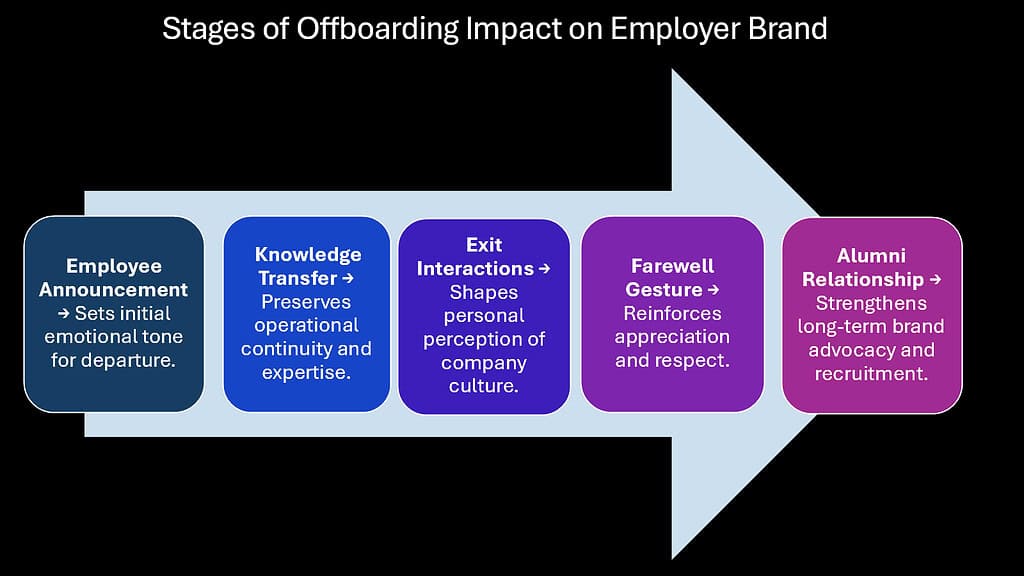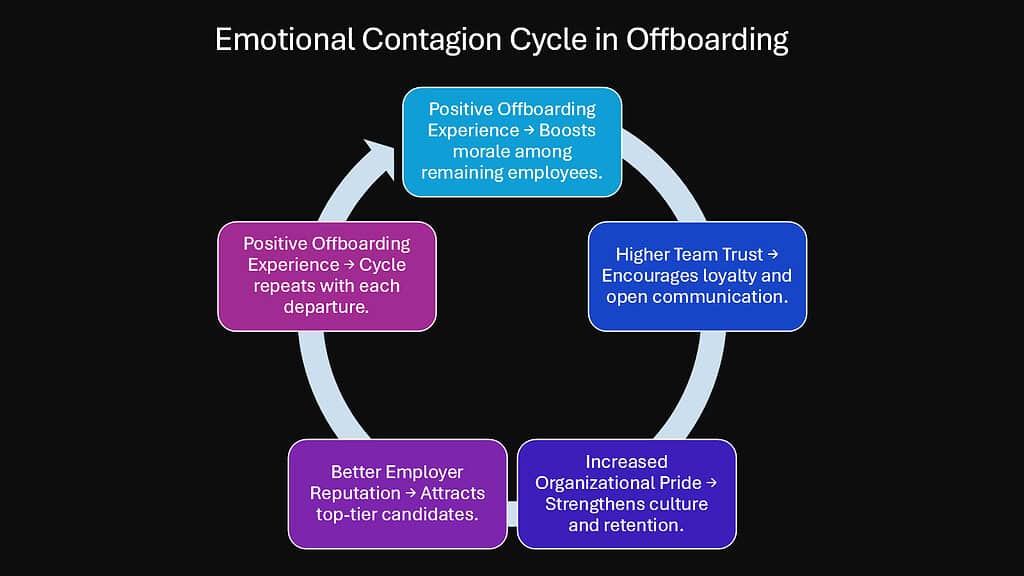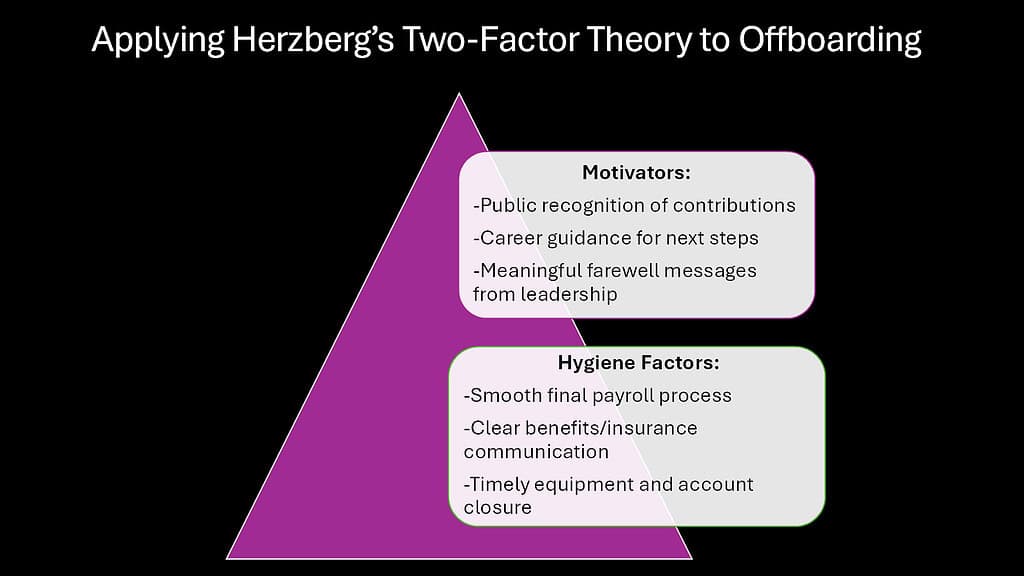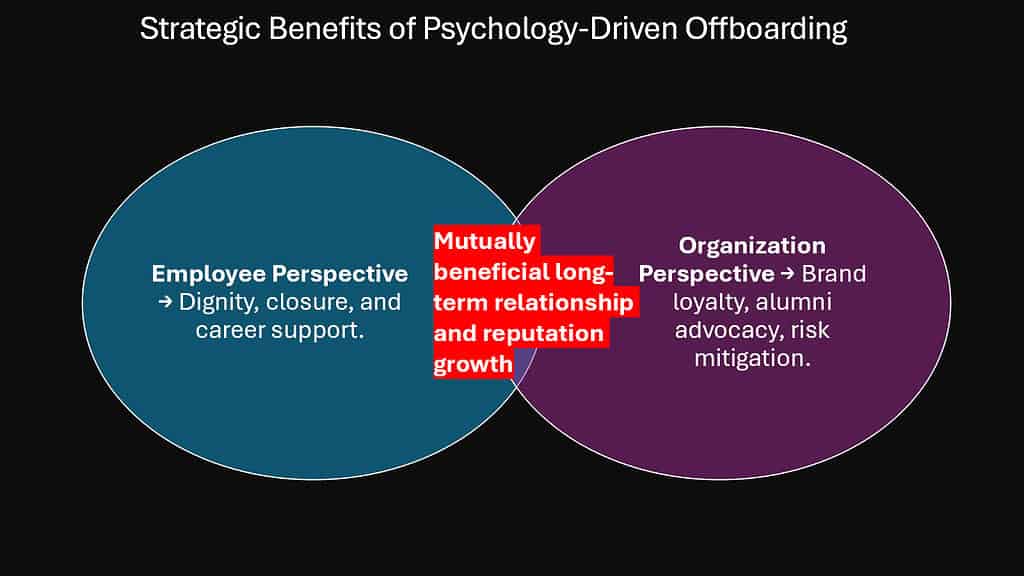Table of Contents
Introduction: Offboarding and the Power of the Last Impression

The final handshake between an employee and their organization carries more weight than most leaders realize. While businesses invest heavily in recruitment and onboarding processes, the art of offboarding often becomes an afterthought—a missed opportunity that can ripple through an organization for years to come. Yet this crucial Human Resources function holds enormous strategic implications that extend far beyond the departing employee’s last day.
Offboarding represents the final chapter in an employee’s journey with an organization, and like any good story, how it ends shapes how the entire experience is remembered. Research from Harvard Business School suggests that employees form lasting impressions about their workplace based on peak moments and endings, making the offboarding process a critical touchpoint for organizational reputation. When executed thoughtfully, offboarding transforms from an administrative burden into a powerful tool for brand building, talent retention, and relationship management.
The psychological principles underlying human memory and emotion provide a roadmap for creating offboarding experiences that leave lasting positive impressions. These final interactions influence not only the departing employee but also remaining team members, future candidates, and even clients who witness the process. Organizations that master the psychology of offboarding discover that exits become opportunities rather than losses.
This exploration examines six proven psychological frameworks that can revolutionize how organizations approach employee departures. From understanding how memory works to leveraging emotional dynamics, these insights reveal how strategic offboarding creates value that extends well beyond the immediate transition. The journey begins with recognizing that every goodbye is also a hello to future possibilities.
The following analysis demonstrates how psychological principles can transform offboarding into a competitive advantage, turning departing employees into lifelong advocates and creating ripple effects that strengthen organizational culture for those who remain.
| HR Function | Impact of Strategic Offboarding |
|---|---|
| Recruitment | Departing employees become brand ambassadors, improving employer reputation and candidate quality |
| Training | Exit insights inform skill gaps and training needs for remaining staff |
| Leadership Development | Provides feedback on management effectiveness and leadership blind spots |
| Employee Relations | Models respectful treatment, building trust and loyalty among remaining employees |
| Employee Engagement | Demonstrates organizational values through actions, reinforcing commitment to all staff |
| Orientation Programs | Exit feedback helps refine new hire experiences and early-stage support systems |
| Organizational Development | Reveals structural issues and opportunities for process improvement |
| Change Management | Creates positive precedents for how the organization handles transitions |
| Onboarding | Exit interviews provide insights that improve new employee integration processes |
| Compensation & Benefits | Departure reasons inform competitive positioning and retention strategies |
1. Offboarding and the Peak-End Rule in Employee Memory
The Peak-End Rule fundamentally changes how organizations should approach employee departures. This cognitive bias, first identified by behavioral economist Daniel Kahneman, reveals that people judge experiences largely based on their most intense moment and how they ended, rather than the overall duration or average quality of the experience. For offboarding, this psychological principle offers a powerful lens through which to design departure experiences that leave lasting positive impressions.
When employees reflect on their time with an organization, their memories become anchored to specific moments rather than distributed evenly across their tenure. A thoughtfully designed offboarding process can strategically create positive peak moments that overshadow earlier workplace frustrations or challenges. Organizations like Google and Microsoft have recognized this principle, investing in farewell celebrations, personalized departure gifts, and comprehensive transition support that creates memorable final experiences.
The neurological basis for the Peak-End Rule lies in how human memory consolidates experiences. The brain naturally emphasizes emotionally significant moments and recent events when forming lasting memories. This means that a mediocre three-year employment experience can be reframed positively through a exceptional final week, while conversely, a rushed or dismissive departure process can taint years of otherwise satisfactory work relationships.
Practical application of the Peak-End Rule in offboarding involves deliberately designing high-impact moments throughout the departure process. This might include personalized farewell messages from leadership, team appreciation ceremonies, or comprehensive career transition support. The key lies in creating genuine emotional peaks that feel authentic rather than manufactured, ensuring the final impression aligns with the organization’s values and the employee’s contribution.
Organizations that master this psychological principle discover that strategic offboarding investments yield returns through improved employer branding, higher boomerang hire rates, and stronger alumni networks. The departing employee’s final impression becomes a story they carry into their professional network, influencing how others perceive the organization long after the individual has moved on.
| Peak-End Rule Application | Traditional Offboarding | Psychology-Informed Offboarding |
|---|---|---|
| Memory Formation | Random experiences create mixed impressions | Deliberately designed peak moments create positive lasting memories |
| Emotional Impact | Administrative focus minimizes emotional connection | Strategic emotional touchpoints maximize positive feelings |
| Final Impression | Often rushed or impersonal | Carefully crafted to reinforce organizational values |
| Long-term Perception | Neutral or negative organizational memory | Positive brand association that influences future recommendations |
| Alumni Relationship | Limited ongoing connection | Foundation for continued professional relationship |
2. Offboarding and Emotional Contagion in Farewell Culture

Emotional contagion represents one of the most underestimated forces in workplace dynamics, particularly during employee departures. This psychological phenomenon describes how emotions spread through groups like ripples in water, with one person’s feelings unconsciously influencing those around them. During offboarding, the emotional tenor set by leadership and departing employees creates cascading effects throughout the organization, shaping team morale and cultural norms around transitions.
The neuroscience of emotional contagion reveals that humans naturally mirror the emotions they observe in others through mirror neurons and unconscious facial mimicry. When a valued team member leaves, their emotional state during the departure process significantly influences how remaining colleagues feel about the organization. A bitter, rushed, or impersonal offboarding creates anxiety and disengagement among remaining staff, while a positive, celebratory departure reinforces feelings of security and appreciation.
Research from the Wharton School demonstrates that emotional contagion in workplace settings can influence productivity, job satisfaction, and turnover intentions across entire departments. Teams that witness respectful, supportive offboarding processes develop stronger trust in leadership and greater confidence in their own job security. Conversely, teams that observe dismissive or hostile departures often experience decreased engagement and increased voluntary turnover in subsequent months.
Organizations like Salesforce have recognized the power of emotional contagion in their departure processes, creating “celebration of contribution” ceremonies that honor departing employees while reinforcing positive cultural messages for those remaining. These practices transform potentially disruptive transitions into opportunities for team building and value reinforcement, demonstrating how emotional intelligence in offboarding can strengthen organizational culture.
The strategic implications extend beyond immediate team dynamics. Remaining employees often serve as informal recruiters, sharing their observations of organizational behavior with their professional networks. When they witness compassionate, professional offboarding, they become advocates who attract quality candidates. When they observe poor treatment of departing colleagues, they may quietly discourage others from joining the organization.
| Emotional Contagion Factor | Negative Impact | Positive Impact |
|---|---|---|
| Leadership Behavior | Dismissive attitudes spread cynicism through teams | Respectful farewells model organizational values |
| Team Dynamics | Anxiety about job security reduces collaboration | Confidence in organizational support strengthens bonds |
| Cultural Messaging | Poor treatment signals low employee value | Thoughtful processes demonstrate genuine care |
| Future Recruitment | Negative stories deter quality candidates | Positive experiences attract top talent |
| Organizational Trust | Erosion of confidence in leadership decisions | Reinforcement of leadership integrity and values |
3. Offboarding and the Service-Profit Chain Mindset
The Service-Profit Chain framework, developed by Harvard Business School researchers, reveals the interconnected relationships between employee satisfaction, customer loyalty, and financial performance. When applied to offboarding, this business model demonstrates how positive departure experiences create value that extends far beyond the immediate transition, influencing client relationships, referral networks, and organizational reputation in measurable ways.
Traditional offboarding views employee departures as isolated events with limited business impact. However, the Service-Profit Chain perspective recognizes that departing employees often maintain relationships with clients, vendors, and industry contacts that can significantly affect future business opportunities. A consultant who leaves on positive terms may recommend their former firm to new clients, while a sales representative who experiences a supportive transition might refer potential customers even after joining a competitor.
Global consulting firm McKinsey & Company exemplifies this approach through their extensive alumni network programs. Former consultants frequently refer new business opportunities, recommend the firm to potential clients, and maintain professional relationships that generate substantial revenue streams. This systematic investment in departure relationships creates a competitive advantage that extends far beyond the immediate cost of comprehensive offboarding programs.
The financial implications become particularly evident in knowledge-intensive industries where client relationships are personal rather than institutional. Professional services firms, technology companies, and healthcare organizations often discover that alumni networks generate significant portions of their new business through referrals and recommendations. Research from the Center for Creative Leadership indicates that organizations with strong alumni relationships experience higher client retention rates and more successful new business development efforts.
Geographic markets present additional considerations for Service-Profit Chain applications in offboarding. In relationship-driven economies like Japan, maintaining face and preserving professional networks through respectful departures becomes critical for long-term business success. European markets with strong worker protection cultures expect comprehensive transition support, making thoughtful offboarding essential for maintaining industry reputation and attracting future talent.
| Service-Profit Chain Element | Offboarding Connection | Business Impact |
|---|---|---|
| Employee Satisfaction | Positive departure experiences create goodwill | Alumni become brand advocates and referral sources |
| Service Quality | Comprehensive knowledge transfer maintains client service | Client relationships remain strong through transitions |
| Client Retention | Departing employees can influence client loyalty | Alumni recommendations strengthen client confidence |
| Revenue Growth | Alumni networks generate new business opportunities | Measurable increases in referral-based revenue |
| Competitive Advantage | Strong departure practices differentiate employer brand | Improved recruitment and retention of top talent |
4. Offboarding and the Reciprocity Effect in Future Relations
The reciprocity principle stands as one of the most powerful forces in human psychology, creating cycles of mutual obligation that extend far beyond initial interactions. When organizations invest genuine care and attention in offboarding processes, they trigger psychological responses that create lasting professional relationships with departing employees. This investment in goodwill generates returns through alumni networks, boomerang hires, and industry advocacy that can span decades.
Psychological research demonstrates that humans possess an innate drive to return favors and match the treatment they receive from others. Organizations that provide comprehensive career transition support, thoughtful farewell recognition, and ongoing alumni engagement create psychological debts that departing employees naturally seek to repay. This reciprocal relationship transforms former employees into external advocates who promote the organization’s interests long after their departure.
Technology companies like Amazon and Apple have mastered the strategic application of reciprocity in their offboarding processes. Former employees frequently return as boomerang hires with enhanced skills and industry knowledge, bringing immediate value that justifies the initial investment in positive departure experiences. Studies from the Society for Human Resource Management indicate that boomerang employees often outperform external hires in productivity and cultural fit, while requiring significantly reduced onboarding time and costs.
The reciprocity effect extends beyond individual relationships to influence entire industry ecosystems. Departing employees who receive exemplary treatment become informal ambassadors within their professional networks, recommending the organization to potential clients, partners, and future employees. This advocacy creates compound returns as each positive departure potentially influences dozens of professional relationships over time.
International business contexts reveal cultural variations in reciprocity expectations that inform effective offboarding strategies. Indian business culture places particular emphasis on maintaining long-term professional relationships and honoring mutual obligations. Japanese organizations often invest heavily in comprehensive departure ceremonies that create lasting bonds of mutual respect. European markets with strong social safety nets expect substantial transition support, making thorough offboarding essential for maintaining positive reciprocal relationships.
The strategic timing of reciprocity investments also influences their effectiveness. Organizations that provide support during vulnerable career transitions create particularly strong psychological bonds. Employees facing involuntary departures, career pivots, or family relocations often remember organizations that provided genuine assistance during difficult periods, creating loyalty that persists throughout their professional careers.
| Reciprocity Investment | Initial Cost | Long-term Return |
|---|---|---|
| Comprehensive Career Coaching | Time and professional development resources | Alumni referrals and industry advocacy |
| Extended Benefits Transition | Short-term financial costs | Reduced litigation risk and positive reputation |
| Alumni Network Participation | Ongoing engagement program costs | Access to industry intelligence and partnerships |
| Boomerang Rehire Programs | Administrative and relationship maintenance costs | Higher performing returnees with reduced onboarding needs |
| Industry Reference Support | Leadership time for recommendations | Enhanced industry relationships and credibility |
5. Offboarding and Herzberg’s Two-Factor Motivation Theory

Frederick Herzberg’s Two-Factor Theory provides crucial insights for designing offboarding processes that minimize dissatisfaction while maximizing goodwill during employee departures. This motivational framework distinguishes between hygiene factors that prevent dissatisfaction and motivators that create positive experiences, offering a roadmap for crafting departure processes that leave employees feeling valued rather than merely processed.
Herzberg identified hygiene factors as basic expectations that, when absent, create significant dissatisfaction but when present, simply maintain neutral feelings. In offboarding contexts, these include timely final paychecks, clear benefit transitions, proper documentation transfers, and respectful treatment during departure conversations. Organizations that fail to address these fundamental needs risk creating lasting negative impressions that can damage relationships and reputation, regardless of other positive gestures.
The motivator factors in Herzberg’s framework create genuine satisfaction and positive feelings that extend beyond basic expectations. Applied to offboarding, these include recognition of contributions, opportunities for meaningful closure, career development support, and personal growth facilitation during the transition. Companies like IBM and General Electric have developed comprehensive departure programs that address both hygiene and motivator needs, creating alumni networks that provide ongoing value to the organization.
Contemporary research from behavioral economics confirms Herzberg’s insights about the asymmetric nature of satisfaction and dissatisfaction. Negative experiences during offboarding carry disproportionate weight in forming lasting impressions, making it essential to address hygiene factors thoroughly before investing in motivational enhancements. A single administrative failure can overshadow multiple positive gestures, while addressing all basic needs creates the foundation for meaningful positive experiences.
The application of Herzberg’s framework reveals why traditional off-boarding often fails to create lasting positive relationships. Many organizations focus exclusively on administrative hygiene factors while ignoring the motivational elements that create genuine appreciation and goodwill. This approach results in neutral departure experiences that miss opportunities to build lasting professional relationships and alumni advocacy.
Different industries and cultural contexts require adapted applications of Herzberg’s principles. Financial services firms must address extensive compliance hygiene factors while creating motivational experiences around career transition support. Healthcare organizations need comprehensive knowledge transfer protocols combined with recognition of professional service contributions. Manufacturing companies require thorough safety and documentation procedures paired with an appreciation for operational expertise and team contributions.
| Herzberg Factor | Offboarding Application | Outcome |
|---|---|---|
| Hygiene Factors | Timely administrative processes, clear communication, respectful treatment | Prevents negative impressions and potential conflicts |
| Recognition | Acknowledgment of contributions and achievements | Creates positive memories and goodwill |
| Achievement | Completion of meaningful projects and knowledge transfer | Provides sense of closure and accomplishment |
| Growth Opportunity | Career coaching and professional development support | Demonstrates ongoing investment in employee success |
| Responsibility | Involvement in transition planning and mentoring successors | Maintains dignity and professional identity during departure |
6. Offboarding and the Narrative Closure Principle
The human mind craves coherent stories with clear beginnings, middles, and ends. The Narrative Closure Principle explains how incomplete or abrupt endings create psychological discomfort and unresolved tension, while thoughtful conclusions provide satisfaction and positive resolution. For offboarding, this psychological need for story completion offers a powerful framework for designing departure processes that create emotional and professional closure for all stakeholders involved.
Narrative psychology research demonstrates that humans naturally organize their experiences into story-like structures, with key events, character development, and meaningful conclusions. When employees leave organizations without proper closure, their professional narrative feels incomplete, often resulting in lingering negative feelings or unresolved conflicts. Conversely, well-designed offboarding processes provide the narrative elements necessary for psychological completion and positive story resolution.
Effective narrative closure in off-boarding involves several key elements that mirror successful storytelling. These include acknowledgment of the journey undertaken, recognition of growth and achievements, resolution of outstanding issues, and clear vision for future chapters. Organizations like Disney and Patagonia have developed departure processes that explicitly frame the employee’s tenure as a meaningful chapter in both personal and organizational stories, creating satisfying narrative conclusions.
The business implications of narrative closure extend beyond individual psychology to influence organizational culture and external perception. Teams that witness complete, respectful departure narratives develop stronger confidence in leadership and greater emotional security about their own professional stories within the organization. Clients and partners observe how employee stories conclude, forming impressions about organizational character and relationship management capabilities.
Cultural considerations significantly influence narrative closure expectations and preferences. American business culture often emphasizes future-oriented closure with focus on next opportunities and continued success. Japanese organizations typically incorporate extensive reflection on shared experiences and mutual contributions. European contexts may emphasize comprehensive documentation and formal recognition of professional relationships developed during tenure.
The timing and structure of narrative closure elements require careful orchestration to maximize psychological impact. Rushed or superficial attempts at story completion often feel hollow and can create more dissatisfaction than no closure at all. Authentic narrative closure requires sufficient time for reflection, genuine acknowledgment of experiences, and meaningful transition to future chapters.
| Narrative Element | Traditional Approach | Closure-Focused Approach |
|---|---|---|
| Story Beginning | Rarely acknowledged | Explicit recognition of joining journey and initial hopes |
| Character Development | Minimal reflection | Comprehensive review of growth, learning, and contributions |
| Plot Resolution | Abrupt ending | Systematic addressing of incomplete projects and relationships |
| Emotional Arc | Ignored or minimized | Acknowledgment of challenges, successes, and emotional journey |
| Future Chapter | Vague well-wishes | Concrete support for transition and vision for continued success |
Conclusion: Offboarding as a Strategic Emotional Asset

The psychology of offboarding reveals a fundamental truth about organizational behavior: how companies handle endings shapes everything that comes before and after. Through the lens of established psychological principles, employee departures transform from administrative necessities into strategic opportunities for building lasting competitive advantages. Organizations that embrace this perspective discover that thoughtful offboarding creates value that compounds over time through alumni networks, enhanced reputation, and strengthened organizational culture.
The six psychological frameworks explored throughout this analysis demonstrate that human behavior during transitions follows predictable patterns that can be leveraged for mutual benefit. The Peak-End Rule shows how strategic final impressions override years of mixed experiences. Emotional contagion reveals how departure dynamics influence entire teams and organizational culture. The Service-Profit Chain connects positive offboarding to measurable business outcomes through client relationships and referral networks.
The reciprocity principle creates cycles of mutual benefit that extend professional relationships far beyond employment tenure. Herzberg’s Two-Factor Theory provides a roadmap for addressing basic needs while creating genuinely positive experiences. The Narrative Closure Principle satisfies fundamental human needs for story completion and meaningful transitions. Together, these insights form a comprehensive framework for transforming departures into strategic assets.
The business implications extend across all organizational functions, creating value that justifies significant investment in comprehensive offboarding programs. Marketing benefits from alumni advocacy and positive employer branding. Sales gains access to extended referral networks and client relationship continuity. Operations improves through comprehensive knowledge transfer and reduced transition disruption. Strategic planning incorporates alumni insights and industry intelligence.
Modern organizations that master psychological principles in offboarding position themselves for sustained competitive advantage in increasingly talent-driven markets. As professional mobility continues to increase and employer-employee relationships evolve, the ability to create positive departure experiences becomes a critical organizational capability. The question is not whether companies can afford to invest in strategic offboarding, but whether they can afford not to harness the psychological principles that turn endings into new beginnings.
| Business Function | Offboarding Impact | Strategic Value |
|---|---|---|
| Marketing | Alumni become brand ambassadors, improving employer reputation and market perception | Enhanced recruitment capabilities and reduced marketing costs |
| Sales | Former employees provide referrals and maintain client relationships | Increased revenue through alumni network business generation |
| Operations | Comprehensive knowledge transfer reduces disruption and maintains productivity | Improved business continuity and reduced transition costs |
| Finance | Reduced turnover costs and improved employee lifetime value calculations | Better talent investment returns and reduced replacement costs |
| Corporate Strategy | Alumni networks provide industry intelligence and partnership opportunities | Enhanced strategic decision-making and market positioning |
| Information Technology | Systematic knowledge documentation and security protocol adherence | Improved data security and reduced technical transition risks |




